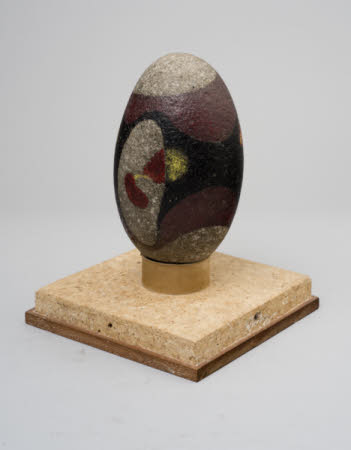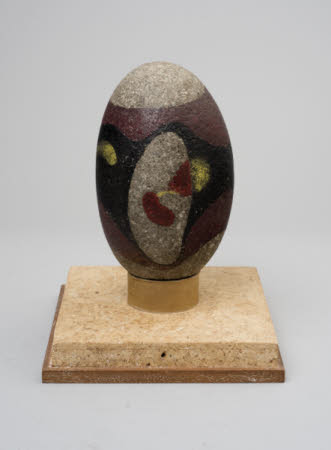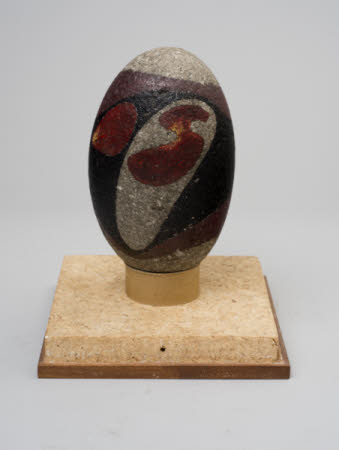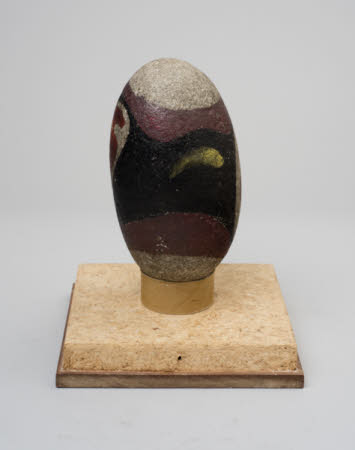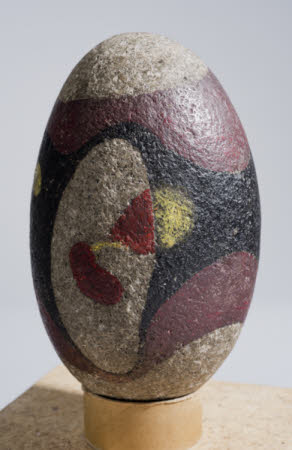Maloja stone and support
Max Ernst (Brühl 1891 – Paris 1976)
Category
Art / Sculpture
Date
1934
Materials
Sculpture: painted stone Support: stone, wood, cardboard and perspex
Measurements
165 x 100 x 90 mm
Place of origin
Switzerland
Order this imageCollection
2 Willow Road, London
NT 112758
Summary
Painted granite pebble stone, from a mountain stream in Maloja in Switzerland, by Max Ernst (1891-1976), 1934. Ovoid shape with a coarse surface texture, with a predominantly black painted surface with ovals of natural stone left unpainted and further ovals of red paint over both the black and unpainted surfaces. Displayed on a stone base with wooden surround, with a cylindrical cardboard support and perspex cover.
Full description
The so-called Maloja stones created in 1934 were Max Ernst’s earliest essays in the art of sculpture. During the summer of that year Ernst stayed in Maloja in the Engadin region of Switzerland, at the invitation of the sculptor Alberto Giacometti. The two men became fascinated by the granite stones they found in a nearby river, that had been worn over time into large smooth shapes. Ernst carved shallow reliefs in some stones, but for most he left their natural form, simply adding selective painted decoration. Ernst described in a letter to a friend their joy in this new art form: ’We are working large and small granite blocks from the moraines of the Forno Glacier. They have been wonderfully worn down by time, ice and weather; just in their natural state they look fantastically beautiful enough; the human hand can really add nothing to this. Why not therefore simply leave the work to the elements and instead content ourselves with scratching into them, rune-like, our secrets?’ The Goldfingers became close friends of Max Ernst, a number of whose works they eventually owned. Jeremy Warren, 2018
Provenance
Acquired in 1939 from Max Ernst for £20, by Ernö Goldfinger. Owned by Ernö Goldfinger and Ursula Ruth Blackwell, also known as Mrs Ernö Goldfinger. Purchased by the National Trust in 1994 with support from the Art Fund, other charitable foundations and private donors.
Credit line
National Trust Collections (2 Willow Road, The Ernő Goldfinger Collection)
Makers and roles
Max Ernst (Brühl 1891 – Paris 1976), artist attributed to Ernő Goldfinger (Budapest 1902 - London 1987), designer
References
Max Ernst, (ex. cat.) London 1952; venue: Institute of Contemporary Arts, London 1952, no. 37 Max Ernst (ex. cat.), New York 1961; venue: Museum of Modern Art, New York and Art Institute of Chicago, 1961, no. 154 Max Ernst (ex. cat.), London 1961; venue: Tate Gallery, London 1961, no. 193 Max Ernst A Retrospective (ex. cat.), New York 1975; venues: Solomon R. Guggenheim Museum, New York and Grand Palais, Paris 1975, no. 161 Max Ernst (ex. cat.), Paris 1975; venue: Galeries nationales du Grand-Palais, Paris 1975, no. 198 Ades 1978: Dawn Ades, Dada and Surrealism Reviewed, (ex. cat.), London 1978; venue: Hayward Gallery, London 1978, p. 305, no. 12.58 Max Ernst. Retrospektive 1979 (ex. cat.), Munich 1979; venues: Haus der Kunst, Munich and Nationalgalerie, Berlin 1979, no. 225 Spies and Metken 1979: Werner Spies, Sigrid and Günter Metken, Max Ernst. Werke 1929-1938, Houston and Cologne 1979, p. 280, no. 2133







